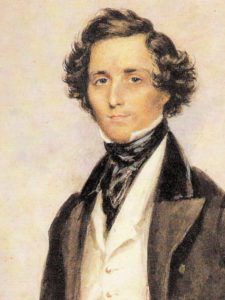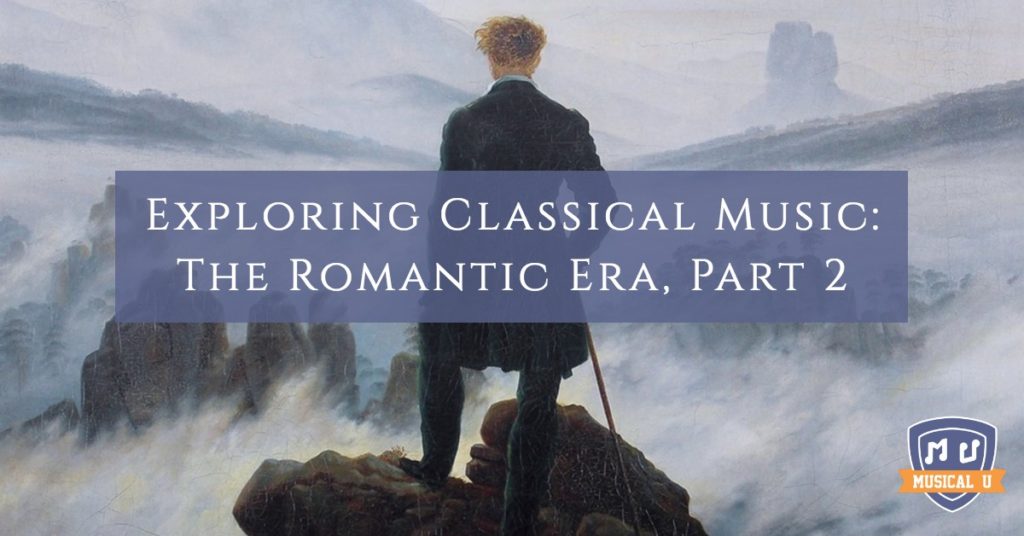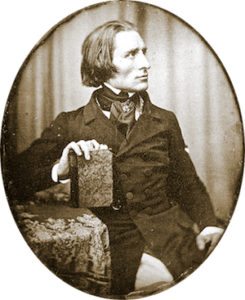The Romantic Era of the Western classical tradition, corresponding roughly to the 1800s, represented a radical shift in how composers saw themselves. In Exploring Classical Music: The Romantic Era, Part 1, we learned how their social situation and music reflected the passionate, emotional aesthetic of the age.
Following in the footsteps of Beethoven, composers obliged their burgeoning middle-class audiences by cultivating their larger-than-life heroic personas, prefiguring today’s rock stars. These romantic celebs composed dramatic music inspired by nature, exoticism, and the supernatural.
In fact, young ladies were known to conceal scissors in their dresses in hopes of snipping off a piece of piano star Franz Liszt’s hair or clothing after the show.
Not all Romantic composers took this radical road, however. Unlike Liszt’s swings between spiritual intensity and earthly profligacy, Mendelssohn lived a happy, family-centered life. That didn’t mean he was a milk-toast: Mendelssohn’s music poured his romantic passion into tried-and-true classical forms.
The Violin Shredded
 Felix Mendelssohn composed his famous Violin Concerto in E Minor in 1844 and adhered to the genre’s history by writing technical passages for the soloist against a large orchestra of diverse timbres. The minor key lends a melancholy vibe to the opening melody, distinct in its disjunct contour (large melodic leaps) and complex passagework (rapid-fire series of notes – the classical equivalent to today’s “shredding”.)
Felix Mendelssohn composed his famous Violin Concerto in E Minor in 1844 and adhered to the genre’s history by writing technical passages for the soloist against a large orchestra of diverse timbres. The minor key lends a melancholy vibe to the opening melody, distinct in its disjunct contour (large melodic leaps) and complex passagework (rapid-fire series of notes – the classical equivalent to today’s “shredding”.)
Classical Form
This first movement (of three total, a norm that 19th-century composers inherited from the form’s baroque-era legacy) is in sonata form – a flexible, three-part form perfected in the Classical Era. Its exposition, development, and recapitulation material are delivered by both soloist and orchestra in rich dialogue.
In this concerto, though, Mendelssohn switched the classical order of things, having the solo violinist play expository material first, then bringing in the orchestral exposition at [1:07]. This serves to thicken the overall texture and presents the main melodic material across various instrumental sounds.
Virtuoso Violin
The piece opens with the gorgeous lyricism inherent to romantic-era music, with an upward-surging, yearning melody built by disjunct motives from [0:09-0:19]. The movement also provides superb examples of the virtuosity expected of a concerto in this age. Listen to the burst of scalar passages at [0:39] and note how Mendelssohn almost silences the orchestra at times (the orchestra only sounds brief punctuations at [0:42] and [0:47], for example), really exploiting the violinist’s sound.
Divergent Development
The development section, marked from [2:30-4:25], is pieced together by lengthy episodes, or material not directly related to the opening theme. Here he explored various key centers, creating tension and instability.
And all while dialogues among instrumental groups, like the soaring clarinet duet at [3:04], divert attention. This section provides contrast even while offering hints of the familiar main theme here and there (listen at [4:27], [6:07], [6:18], and [6:30]), yet the full sense of relief and recognition only comes with the official recapitulation.
Cadenza
Before that return to the opening theme, though, the soloist is granted a cadenza at [7:24]. With the orchestra silenced, it’s the soloist’s opportunity to shine (and 19th-century concert-goers would have waited patiently for this very dramatic moment). A soaring sequence of scales, working of the instrument’s entire melodic range, low to high characterizes this almost improvisatory-sounding passage.
This cadenza makes clear how well Mendelssohn understood the violin and how he wrote idiomatically for it (that is, he wrote to the instrument’s capabilities). He handily exploited the violin’s ability to render stark contrasts in timbre via bow effects and dynamics shifts. Listen from [8:15-8:30] for a pattern that includes trills on different pitches followed by thicker sounding double-stops (where the player draws the bow across multiple strings to create chords). The solo arpeggiated playing that begins at [8:38] will accelerate to signal the orchestra to join in at [9:04] for another full statement of the recurring theme, or ritornello, and to initiate the final run toward the conclusion.
The Piano Possessed
By all reviews, Franz Liszt’s playing ability was in his time unsurpassed, and his compositions inspire pianists to this day. His piano études are important to the genre category of “character piece“, a one-movement solo piece that boasts programmatic content. An étude in particular tests a pianist to master a specific performance problem: by featuring extreme musicality and virtuosic display, though, Liszt’s études present both a technical challenge for the pianist and material engaging enough for the listener. Far from just “lesson pieces,” Liszt’s études are showpieces for the concert stage.
 Forest Murmurs
Forest Murmurs
“Waldesrauschen” (Forest Murmurs) is from a set of Two Concert Études, S. 145 (1862), and here it proves valuable to observe the pianist, noting just how physical the act of realizing a Liszt étude tends to be. The player is in constant motion, working Liszt’s goal of exploiting what was for him a fascinating stand-alone instrument. The piano had come a long way during the 1800s, boasting an expanded range and improved dynamic and sustain properties. Liszt used all of the above to his expressive advantage, imparting to the listener the muted rustling of wind in the trees.
The opening measures put into motion a shimmering right-hand arpeggiated figure alongside a prominent, singable left-hand melody (which recurs to bind the four-minute étude into a coherent whole).
Note the shift at [0:42], when the melodic material emerges instead in a broader right-hand passage, leaving the left hand to handle the arpeggios. By [1:17], things alter again—and we’re getting the hint that Liszt wanted a player to manage deftly these shifts between right and left- hand emphases. Here the pianist pushes the left-hand melody, all while fluttering figures parade above in the higher right-hand range.
Piano Virtuosity
At [1:54], the right hand mimics that song-like tune, now in octaves, and Liszt imposes sequencing (repeating the exact passage up or down in pitch) to develop the musical material. Watch the pianist carefully from [2:10-2:25] as the piece works to its climax where the movement and intensity required to execute all that a Liszt score demands is on full display.
The right hand remains vital for expressing the theme as the octave version of that material continues on through [2:46]. At [2:48] Liszt imparts an articulation change that lightens the mood with playful staccato hits on the keyboard.
This compact B-section (in the overall A-B-A ternary form) is still intent on exploiting the high range of this evolved instrument. The following virtuosic cascade of notes at [3:03], descends to land on a sort of static, murmuring transition (note the dynamic capabilities of the instrument) leading at [3:22] to a clear return of the opening idea.
Transcending the Limits
Early in his career, Franz Liszt realized that could secure his fame and fortune by developing his piano virtuosity to an almost supernatural level, and then composing spectacular music that only he (at that time) was capable of playing. With concert études like “Waldesrauschen”, Liszt seriously raised the bar for his contemporaries and pianists to follow.
We owe our current cultural image of the artist/celebrity/entrepreneur to Liszt, Mendelssohn and the other romantic-era rock stars that cultivated the individual “branding” of their powerful music.
Are you ready for some of the most exciting, lovely and sublime music ever? Dial in your Romantic Era station today and be prepared to be seriously moved.


 Forest Murmurs
Forest Murmurs




